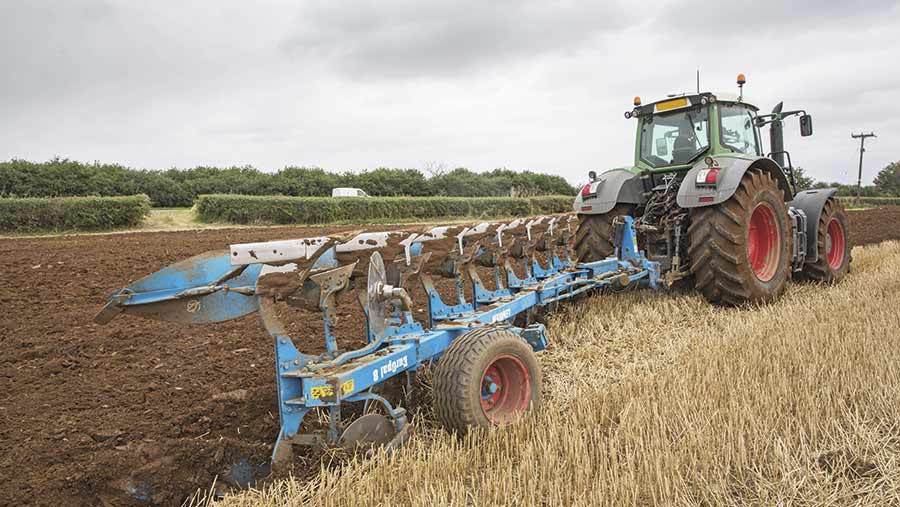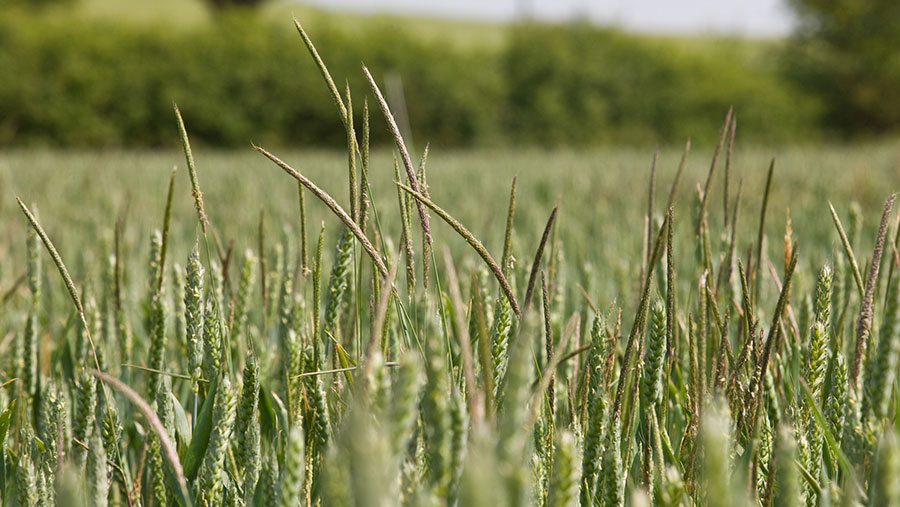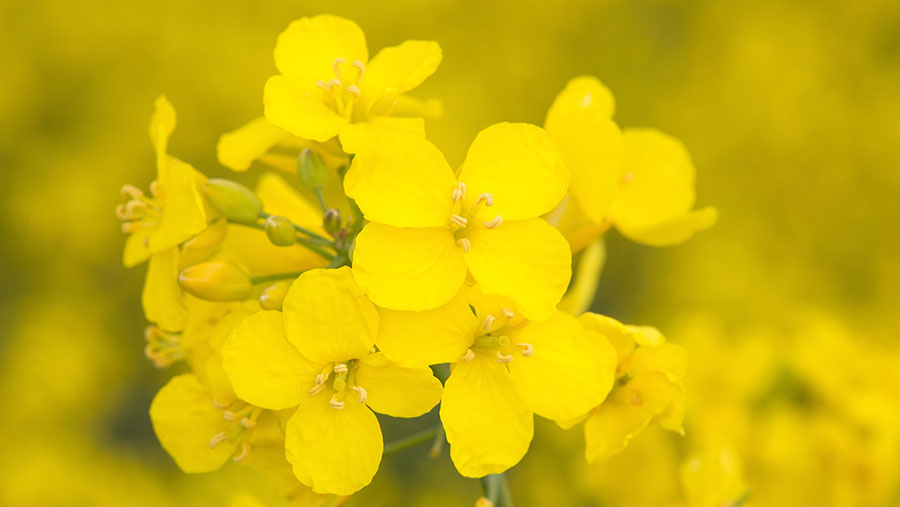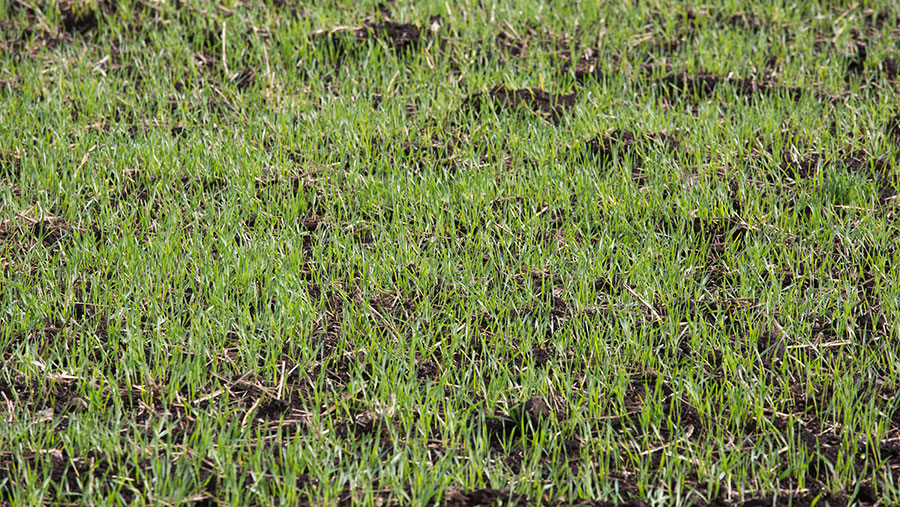Video: The plan that battered blackgrass in 12 months
 © Tim Scrivener
© Tim Scrivener Three Cambridgeshire growers are fighting back against a heavy yield penalty imposed by blackgrass with a new establishment system and have seen a dramatic turnaround in just 12 months.
Declining effectiveness of chemical control culminated in harvest 2015 when David Felce and brothers David and Stephen Ellerbeck saw crop yields halve from 11-12t/ha to 5-6t/ha in the worst areas.
Now they have pushed back drilling dates, ploughed the most blackgrass-infested land, used low-disturbance cultivation equipment on the rest and widened their rotation.
See also: Why 2017 was a bad lodging year – and how to avoid it in future
They say the combined effect has hit blackgrass hard, and there is no barrier to farms large or small getting to grips with the effects of the troublesome grassweed as the changes have been largely cultural.
The farming trio manages two adjoining holdings together in a contract farming agreement which was set up in 2003 as a means of cutting costs when wheat prices crashed to below £60/t.
The 270ha cropping area of chalky boulder clay, near Huntingdon, grew two wheat crops followed by oilseed rape in a tight rotation typical of the area when the profitability of these crops was well ahead of any alternatives.
Cultivations were done with a power harrow and tine drill, and the plough was routinely used before second wheats.
The upshot of this was blackgrass was able to rapidly escalate once the effectiveness of herbicides declined, as vast numbers of weed seeds were being mixed through the soil profile and encouraged to germinate just as crops were planted.

© Tim Scrivener
Time for a change
The resulting yield penalties saw profitability plummet and by 2015 the lifelong friends decided they had to make radical changes.
“It is not just buying a new drill or cultivator it is changing everything or you are not going to win,” says Mr Felce, who is also a regional technical adviser for agronomy company Agrii.
Impressed by results of long-term blackgrass trials at Agrii’s Stow Longa site, situated only a few miles away, they decided to put the research into practice on a whole-farm scale.
That’s because the research shows making one appropriate step in isolation, such as low-disturbance drilling, will have little impact unless every effort is made throughout the season to stop as many weed seeds as possible from germinating.
Oilseed rape area slashed

© Tim Scrivener
Their starting point was the rotation, and they pinpointed oilseed rape as the main culprit for allowing blackgrass populations to survive and spread more seed, which then caused havoc in following wheat crops.
Although rapeseed is the most profitable break available, they say its early establishment date puts it straight into competition with the grassweed when it is growing vigorously in warm soils.
That issue is then compounded by a combination of cabbage stem flea beetle damage and the crop’s naturally open canopy, leaving too much ground where daylight can penetrate and allow blackgrass to flourish.
The oilseed rape area has been slashed back to 35ha of the cleanest land, and second wheats have been dropped completely as they were yielding less than first wheats for the same cost of production.
The vacated cropping area has been filled with a combination of winter beans, spring wheat and spring barley.
The competitive spring barley variety Explorer was selected for the land ranked the worst for blackgrass, with the premium offered by the brewer Budweiser a useful bonus.
Winter beans have also brought benefits, as they allow many of the break crop herbicides to be retained, such as Kerb (propyzamide) and Crawler (carbetamide), and also have useful nitrogen-fixing properties and conditioning the soil and so providing an ideal entry point for winter wheat.
The crop also has a later drilling date, and Stephen says it is a good opportunity in the rotation to put the plough in the ground.
Strategic ploughing
Although ploughing was practised before, another leg to the strategy is adopting a more targeted approach instead of going in like clockwork before a certain crop.
(See Paul Creasy, Lemken’s general manager, demonstrate the best way to set up your plough to bury blackgrass)
While the practice runs counter to the remainder of cultivations, which aim to move as little soil as possible, ploughing can be a useful reset button, explains Stephen, to bury weed seed below germination depth.
This means it is critical to not plough the same field more than once every four years, to give the blackgrass seed time to rot down, and when ploughing is done, to ensure conditions are appropriate to allow the whole field to be properly inverted.
For example, although last year the land was rock-hard at harvesting after a long dry spell, conditions this year have been softer, and with straw being baled there is significant compaction in wheelings.
The team say it’s been absolutely crucial to get out with the spade and find exactly what depth the compaction is at and set the cultivator appropriately.
Low-disturbance legs, rippers, or discs used for cultivations in years following ploughing must operate above plough depth to avoid mixing soil back through the profile, which will drag weed seeds back to germination depth.
Delayed drilling

© Tim Scrivener
Autumn drilling on higher-risk ground is delayed until late October to leave a big gap between primary cultivations and drilling, with seed-beds left undisturbed for between four and six weeks.
Leaving ground set up for drilling for this length of time may seem like a big ask but it allows as much blackgrass as possible to germinate and then means as little soil as possible around the seed is moved at drilling, to prevent weeds chitting.
Late-planted crops will also benefit from cooling soils, which provide optimum conditions mean a more hostile growth environment for the weed and optimum working conditions for expensive pre-emergence herbicides.
But unlike many growers who have gone with multiple light cultivations and following glyphosate sprays, the team have opted for just one application a day or two before drilling.
Mr Felce explains no matter how many plants are sprayed off, growers are still only taking out a fraction of the seed population, meaning it is more cost effective to leave as many as possible undisturbed.
Broadening the rotation can throw up fresh challenges for growers as the income from many crops is close to the breakeven point, but the team have been pleased with its choices.
When it comes to drilling, they credit the rented Easy Drill from Sky Agriculture with being able to do a good job in a range of conditions but stress that for growers without access to expensive implements, good results can often be achieved by modifying existing kit.
Depending on the weather, it can be difficult knowing what conditions to leave seed-beds in, and while the drill is versatile, they say conditions look wrong, just stop.
That’s because there is no penalty for delaying drilling, even through to spring, that will eclipse the price paid for drilling in poor conditions, getting poor emergence, and poor performance from pre-emergence herbicides and allowing blackgrass to flourish.
Six cheaper ways to fight blackgrass
- A longer crop rotation This presents a range of challenges to blackgrass by allowing the use of more cultivation techniques and herbicides.
- Early primary cultivations Getting seed-beds ready to drill four to six weeks ahead of drilling will allow ample time for blackgrass to germinate and be sprayed off.
- Later autumn drilling dates This allows crops to establish when soils are cooler and blackgrass is less competitive. Pre-emergence herbicides also work better in cooler soils.
- Spring-planted crops This takes the pressure off pushing drilling dates later in the autumn and is another opportunity to plant when blackgrass is less competitive.
- Ploughing as a “reset button” This can be helpful to bury large amounts of weed seed but only if ploughed well and seed is left buried long enough to become inactive. This means that ploughing can only take place every four years as a minimum. Soils should also not be aggressively cultivated.
- Moving as little soil as possible at drilling Use of a low-disturbance drill, or a more traditional model retro-fitted with lower disturbance kit will ensure as many weed seeds as possible remain buried.

